Canon PowerShot A620
Review Date: January 11th 2006
|
Ease of Use
The Canon PowerShot A620 falls into the "mid-sized" category of cameras; it's neither small enough to fit in a pocket, nor big/heavy enough for you to really notice it. The A620 will easily fit into a small camera bag. The overall finish of the Canon PowerShot A620 belies its price tag - this is a camera that looks and feels a lot more expensive than it actually is. The stylish silver plastic body is very well constructed with nothing feeling flimsy or ill-thought out.
The Canon PowerShot A620 is very comfortable to hold, mostly thanks to the large handgrip that protrudes out from the front of the camera. Your right thumb is naturally positioned to the right of the play/camera switch, whilst operating the shutter button and zoom lever with your right index finger. You can also comfortably hold the camera and take pictures with one hand. Despite the smooth all-plastic body, the camera is not too slippy when gripping it. The various buttons are well-made and easy to operate, and the camera feels well-balanced in your hands. There are no real innovative features here, but everything that the Canon PowerShot A620 does, it does very well. Overall the Canon PowerShot A620 is well constructed and designed with no obvious signs of corners being cut.
It's been a while since I've used a camera with a flip-out, twistable LCD screen, and I'd forgotten just how much fun they can be. The one on the Canon PowerShot A620 can be used in a variety of different positions, including one that easily allows you to take a self-portrait (see illustration below). You can also use it as a waist-level finder for more candid moments. The screen seems to be robustly built, clicking into the various positions, and can be closed flat against the back of the camera when not in use to protect it.
| Mode Dial | Navigation Pad / Function/Set button |
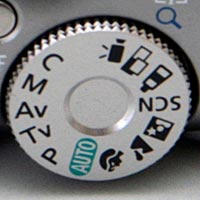 |
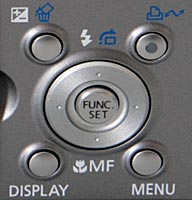 |
The Canon PowerShot A620 has relatively few external controls, just 11 in total, which is quite surprising considering that this camera offers a full range of photographic controls. Cleverly you can directly access the various flash, exposure compensation, macro and timer options by clicking on the the navigation pad and the four buttons around it. There is also a sub-menu accessed via the Function/Set button in the middle of the navigation pad, which allows you to set ISO speed, white balance, drive mode, image effects, flash compensation, metering and image size/quality settings. This system is a good compromise given the relative compactness of the camera and the large area required for the LCD screen. All 11 external controls are clearly labeled using industry-standard symbols and terminology. Overall the camera body feels very well-designed and not at all cluttered, despite the presence of the large, twistable 2 inch LCD screen. An adequately sized optical viewfinder is also included, which is welcome for moments when it is difficult to use the LCD screen i.e. in very bright sunlight.
If you have never used a digital camera before, or you're upgrading from a more basic model, reading the comprehensive and fairly easy-to-follow manual before you start is a good idea. Unfortunately Canon have chosen to cut costs and only supply it as a PDF on a CD, rather than in printed format. Not much use if you're taking pictures and need to find out what a particular option does.
| On/Off button / Zoom Lever / Shutter button | Self-portrait mode! |
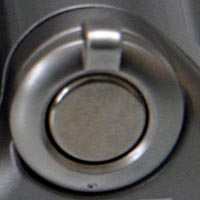 |
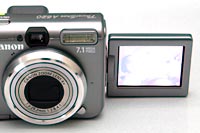 |
The menu system on the Canon PowerShot A620 is extremely straight-forward to use and is accessed by a dedicated button underneath the navigation pad. Quite a lot of the camera's main settings, such as white balance, exposure compensation and ISO speed, are accessed elsewhere, so the main menu system isn't actually that complicated. A row of 3 icons along the top of the LCD screen represents the various sub-menus, with most of them being the kind that you set once and then forget about. Due to the large and bright LCD screen, the various options are easy to access and use, especially as only six options are shown onscreen at one time.
The Canon PowerShot A620 offers a range of advanced exposure modes, including shutter-priority, aperture-priority and manual, perfect for the photographer who wants to take full control. It also offers some features that you won't find on other digital cameras. Set the mode dial to My Colors, press the Function button and select the My Colors option to reveal the Custom Color menu, which includes a number of pre-set looks, such as Positive Film and Vivid Green. These are a quick way of achieving a particular effect. More exciting are the Color Accent and Color Swap options in the same menu. Color Accent allows you to select one colour and render the rest of the image in black and white, whilst Color Swap lets you select a colour in the image and change it for another completely different one. As far as I know, Canon are the only manufacturer to offer what is quite an advanced feature directly in their cameras
| Memory Card Slot | Battery Compartment |
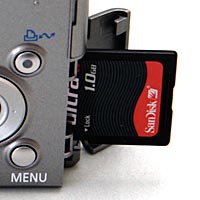 |
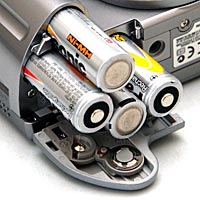 |
The start-up time from turning the Canon PowerShot A620 on to being ready to take a photo is quick at around 1 second, and it takes about 3 seconds to zoom from the widest focal length to the longest, and back again. Focusing is very quick in good light and the camera happily achieves focus indoors or in low-light situations, helped by a powerful focus-assist lamp. The visibility and refresh rate of the 2.5 inch LCD screen are perfectly acceptable, although the resolution is a little on the low side. It takes about 1 second to store an image, allowing you to keep shooting as they are being recorded onto the memory card - there is no LCD blackout between each image. In Continuous mode the camera takes 1.9 frames per second at the highest image quality, which is quick for this class of camera, and best of all this shooting rate is maintained until your memory card is full! All in all the Canon PowerShot A620 is quite fast in terms of operational speed.
Once you have captured a photo, the Canon PowerShot A620 has an excellent range of options when it comes to playing, reviewing and managing your images. You can instantly scroll through the images that you have taken, view thumbnails, zoom in and out up to 10x magnification, view slideshows, delete, protect, and rotate an image. You can also add a sound clip to an image, set the print order and the transfer order. The Display button toggles detailed settings information about each picture on and off, such as the ISO rating and white balance, and there is a small histogram available during playback which is helpful in evaluating the exposure.
In summary the Canon PowerShot A620 is a stylish, well built and easy to use digital camera that offers as little or as much control as you require.
|
 PhotographyBLOG
is a member of the DIWA
organisation. Our test results for the Canon PowerShot A620
have been submitted to DIWA
for comparison with test results for different samples of
the same camera model supplied by other DIWA
member sites.
PhotographyBLOG
is a member of the DIWA
organisation. Our test results for the Canon PowerShot A620
have been submitted to DIWA
for comparison with test results for different samples of
the same camera model supplied by other DIWA
member sites.
